
Niacinamide or nicotinamide is a form of vitamin B3 found in food and used as a dietary supplement and medication. As a supplement, it is used by mouth to prevent and treat pellagra (niacin deficiency). While nicotinic acid (niacin) may be used for this purpose, niacinamide has the benefit of not causing skin flushing. As a cream, it is used to treat acne. It is a water-soluble vitamin. Niacinamide is the supplement name while nicotinamide is the scientific name.
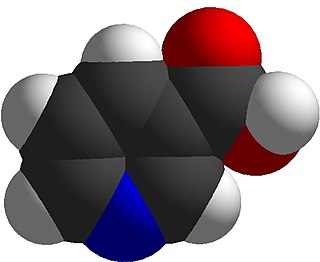
Niacin, also known as nicotinic acid, is an organic compound and a form of vitamin B3, an essential human nutrient. It can be manufactured by plants and animals from the amino acid tryptophan. Niacin is obtained in the diet from a variety of whole and processed foods, with highest contents in fortified packaged foods, meat, poultry, red fish such as tuna and salmon, lesser amounts in nuts, legumes and seeds. Niacin as a dietary supplement is used to treat pellagra, a disease caused by niacin deficiency. Signs and symptoms of pellagra include skin and mouth lesions, anemia, headaches, and tiredness. Many countries mandate its addition to wheat flour or other food grains, thereby reducing the risk of pellagra.

Nicotine is a naturally produced alkaloid in the nightshade family of plants and is widely used recreationally as a stimulant and anxiolytic. As a pharmaceutical drug, it is used for smoking cessation to relieve withdrawal symptoms. Nicotine acts as a receptor agonist at most nicotinic acetylcholine receptors (nAChRs), except at two nicotinic receptor subunits where it acts as a receptor antagonist.

Tobacco smoke is a sooty aerosol produced by the incomplete combustion of tobacco during the smoking of cigarettes and other tobacco products. Temperatures in burning cigarettes range from about 400 °C between puffs to about 900 °C during a puff. During the burning of the cigarette tobacco, thousands of chemical substances are generated by combustion, distillation, pyrolysis and pyrosynthesis. Tobacco smoke is used as a fumigant and inhalant.
Nicotine gum is a chewing gum containing the active ingredient nicotine polacrilex. It is a type of nicotine replacement therapy (NRT) used alone or in combination with other pharmacotherapy for smoking cessation and for quitting smokeless tobacco.

N-Nitrosonornicotine (NNN) is a tobacco-specific nitrosamine produced during the curing and processing of tobacco.
Isonicotinic acid or pyridine-4-carboxylic acid is an organic compound with the formula C5H4N(CO2H). It is a derivative of pyridine with a carboxylic acid substituent at the 4-position. It is an isomer of picolinic acid and nicotinic acid, which have the carboxyl group at the 2- and 3-position respectively compared to the 4-position for isonicotinic acid.

Picolinic acid is an organic compound with the formula C5H4N(CO2H). It is a derivative of pyridine with a carboxylic acid (COOH) substituent at the 2-position. It is an isomer of nicotinic acid and isonicotinic acid, which have the carboxyl side chain at the 3- and 4-position, respectively. It is a white solid that is soluble in water.

Nicocodeine is an opioid analgesic and cough suppressant, an ester of codeine closely related to dihydrocodeine and the codeine analogue of nicomorphine. It is not commonly used in most countries, but has activity similar to other opiates. Nicocodeine and nicomorphine were introduced in 1957 by Lannacher Heilmittel of Austria. Nicocodeine is metabolised in the liver by demethylation to produce nicomorphine, also known as 6-nicotinoylmorphine, and subsequently further metabolised to morphine. Side effects are similar to those of other opiates and include itching, nausea and respiratory depression. Related opioid analogues such as nicomorphine and nicodicodeine were first synthesized. The definitive synthesis, which involves treating anhydrous codeine base with nicotinic anhydride at 130 °C, was published by Pongratz and Zirm in Monatshefte für Chemie in 1957, simultaneously with the two analogues in an article about amides and esters of various organic acids.
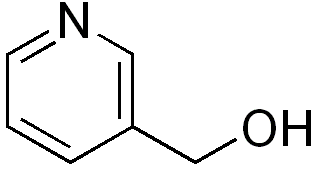
Nicotinyl alcohol (pyridylcarbinol) is a niacin derivative used as a hypolipidemic agent and as a vasodilator. It causes flushing and may decrease blood pressure.
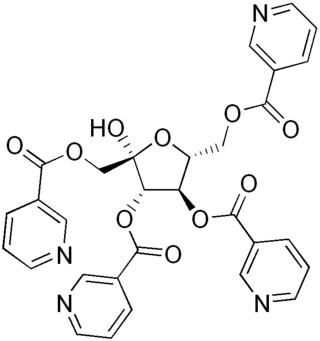
Nicofuranose is a niacin derivative used as a hypolipidemic agent.

Desformylflustrabromine (dFBr) is a monomethyltryptamine derivative which was first isolated as a secondary metabolite of the marine bryozoan Flustra foliacea.

Hydroxycarboxylic acid receptor 2 (HCA2), also known as niacin receptor 1 (NIACR1) and GPR109A, is a protein which in humans is encoded by the HCAR2 gene. HCA2, like the other hydroxycarboxylic acid receptors HCA1 and HCA3, is a Gi/o-coupled G protein-coupled receptor (GPCR). The primary endogenous agonists of HCA2 are D-β-hydroxybutyric acid and butyric acid (and their conjugate bases, β-hydroxybutyrate and butyrate). HCA2 is also a high-affinity biomolecular target for niacin (aka nicotinic acid).
Vitamins occur in a variety of related forms known as vitamers. A vitamer of a particular vitamin is one of several related compounds that performs the functions of said vitamin and prevents the symptoms of deficiency of said vitamin.
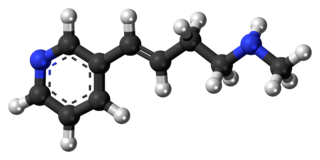
Rivanicline is a drug which acts as a partial agonist at neural nicotinic acetylcholine receptors. It is subtype-selective, binding primarily to the α4β2 subtype. It has nootropic effects and was originally developed as a potential treatment for Alzheimer's disease, but a second action that was subsequently found was that it inhibits the production of Interleukin-8 and thus produces an antiinflammatory effect, and so it has also been developed as a potential treatment for ulcerative colitis. Rivanicline also has stimulant and analgesic actions which are thought to be mediated through stimulation of noradrenaline release, and so it could also have other applications. It has been identified as constituent of tobacco as well.

ABT-418 is a drug developed by Abbott, that has nootropic, neuroprotective and anxiolytic effects, and has been researched for treatment of both Alzheimer's disease and ADHD. It acts as an agonist at neural nicotinic acetylcholine receptors, subtype-selective binding with high affinity to the α4β2, α7/5-HT3, and α2β2 nicotinic acetylcholine receptors but not α3β4 receptors ABT-418 was reasonably effective for both applications and fairly well tolerated, but produced some side effects, principally nausea, and it is unclear whether ABT-418 itself will proceed to clinical development or if another similar drug will be used instead.
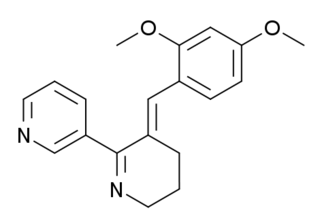
GTS-21 (DMXBA) is a derivative of the natural product anabaseine that acts as a partial agonist at neural nicotinic acetylcholine receptors. It binds to both the α4β2 and α7 subtypes, but activates only the α7 to any significant extent.

Acetamiprid is an organic compound with the chemical formula C10H11ClN4. It is an odorless neonicotinoid insecticide produced under the trade names Assail, and Chipco by Aventis CropSciences. It is systemic and intended to control sucking insects (Thysanoptera, Hemiptera, mainly aphids) on crops such as leafy vegetables, citrus fruits, pome fruits, grapes, cotton, cole crops, and ornamental plants. It is also a key pesticide in commercial cherry farming due to its effectiveness against the larvae of the cherry fruit fly.
Nicotine salts are salts formed from nicotine and an acid. They are found naturally in tobacco leaves. Various acids can be used, leading to different conjugate bases paired with the ammonium form of nicotine.
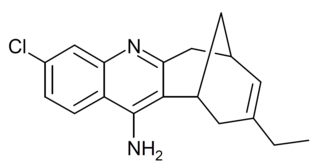
Huprine X is a synthetic cholinergic compound developed as a hybrid between the natural product Huperzine A and the synthetic drug tacrine. It is one of the most potent reversible inhibitors of acetylcholinesterase known, with a binding affinity of 0.026nM, as well as showing direct agonist activity at both nicotinic and muscarinic acetylcholine receptors. In animal studies it has nootropic and neuroprotective effects, and is used in research into Alzheimer's disease, and although huprine X itself has not been researched for medical use in humans, a large family of related derivatives have been developed.
















